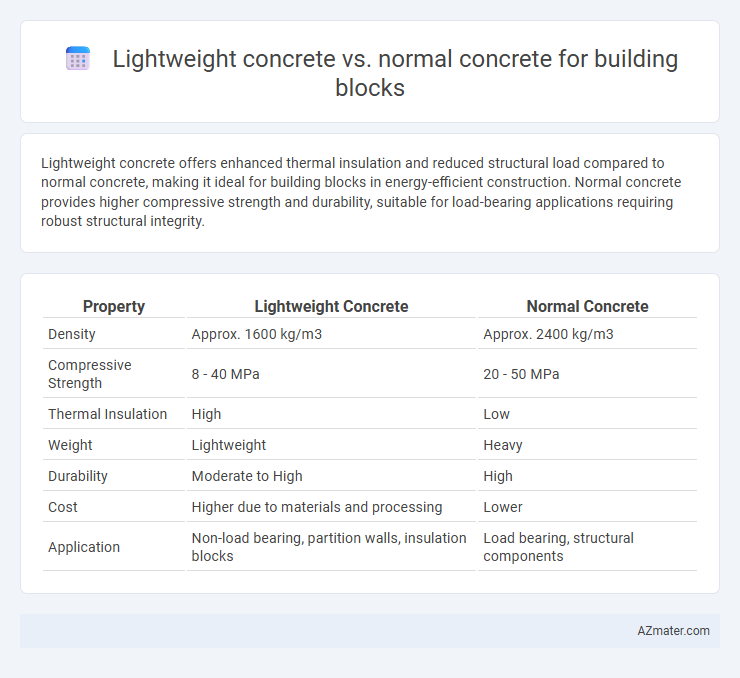Lightweight concrete offers enhanced thermal insulation and reduced structural load compared to normal concrete, making it ideal for building blocks in energy-efficient construction. Normal concrete provides higher compressive strength and durability, suitable for load-bearing applications requiring robust structural integrity.
Table of Comparison
| Property | Lightweight Concrete | Normal Concrete |
|---|---|---|
| Density | Approx. 1600 kg/m3 | Approx. 2400 kg/m3 |
| Compressive Strength | 8 - 40 MPa | 20 - 50 MPa |
| Thermal Insulation | High | Low |
| Weight | Lightweight | Heavy |
| Durability | Moderate to High | High |
| Cost | Higher due to materials and processing | Lower |
| Application | Non-load bearing, partition walls, insulation blocks | Load bearing, structural components |
Introduction to Lightweight and Normal Concrete
Lightweight concrete is made with lightweight aggregates such as expanded clay, shale, or pumice, which reduce the density and improve thermal insulation compared to normal concrete that uses traditional aggregates like gravel and sand. Normal concrete typically exhibits higher compressive strength and durability, making it suitable for structural applications, whereas lightweight concrete offers advantages in reducing dead load and improving fire resistance. Both types are widely used in building blocks, with the choice depending on specific architectural and engineering requirements such as load-bearing capacity and energy efficiency.
Composition Differences Between Lightweight and Normal Concrete
Lightweight concrete for building blocks typically incorporates lightweight aggregates such as expanded clay, shale, or pumice, which significantly reduce the density of the mix compared to normal concrete that uses conventional aggregates like gravel and sand. The cementitious material proportions in lightweight concrete are adjusted to maintain strength while achieving lower weight, often resulting in higher water-to-cement ratios and the inclusion of air-entraining agents for enhanced insulation and durability. Normal concrete, by contrast, relies on standard aggregates and a denser mix composition, providing higher compressive strength but increased weight, which impacts structural load and thermal properties.
Density and Weight Comparison
Lightweight concrete typically has a density ranging from 1,200 to 1,800 kg/m3, significantly lower than normal concrete, which ranges between 2,200 and 2,500 kg/m3. This reduction in density translates to lighter weight building blocks, improving ease of handling, reducing structural load, and enhancing thermal insulation. The lower density of lightweight concrete is achieved by incorporating lightweight aggregates like expanded clay or shale, making it ideal for applications where weight reduction is critical without compromising strength.
Structural Strength and Load-Bearing Capacity
Lightweight concrete offers reduced density ranging from 800 to 1900 kg/m3, providing significant advantages in seismic-resistant construction, though it generally exhibits lower compressive strength, typically 10-30 MPa, compared to normal concrete's strength of 20-40 MPa used in building blocks. Normal concrete's higher density, approximately 2200-2500 kg/m3, translates to superior load-bearing capacity and structural strength, making it preferable for heavy structural elements requiring durability and high compressive strength. Structural engineers often select lightweight concrete for non-load-bearing partitions and insulation benefits, while normal concrete remains the choice for critical load-bearing walls and foundation blocks due to its proven strength and stability.
Thermal and Acoustic Insulation Properties
Lightweight concrete offers significantly better thermal insulation compared to normal concrete due to its lower density and higher porosity, reducing heat transfer in building blocks. Acoustic insulation is also enhanced in lightweight concrete as its porous structure absorbs sound waves more effectively, minimizing noise transmission. Normal concrete, while stronger and denser, provides less effective insulation properties, making lightweight concrete the preferred choice for energy-efficient and noise-reducing building applications.
Workability and Handling in Construction
Lightweight concrete offers superior workability compared to normal concrete due to its lower density and enhanced plasticity, facilitating easier mixing, placing, and finishing during construction. The reduced weight significantly improves handling and transportation efficiency, minimizing labor costs and reducing structural load on building blocks. Normal concrete, while denser and stronger, often requires more effort for placement and curing, which can slow down construction processes and increase the risk of improper compaction.
Durability and Longevity of Building Blocks
Lightweight concrete building blocks exhibit enhanced durability and longevity due to their lower density, which reduces stress on structural elements and improves resistance to cracking and freeze-thaw cycles. Normal concrete blocks possess higher compressive strength but are more prone to shrinkage and environmental degradation over time. The optimized pore structure in lightweight concrete enhances moisture resistance, significantly extending the lifespan of building blocks in various climatic conditions.
Cost Implications and Economic Considerations
Lightweight concrete typically incurs higher initial material costs compared to normal concrete, but its lower density reduces transportation and handling expenses significantly. The economic benefits of lightweight concrete often manifest in savings on structural support requirements and foundation costs due to decreased dead load. Normal concrete remains more cost-effective for projects with minimal load constraints or where material cost is the primary concern.
Environmental Impact and Sustainability
Lightweight concrete significantly reduces environmental impact due to its lower density and reduced raw material consumption, leading to less energy-intensive production compared to normal concrete. Its enhanced thermal insulation properties contribute to energy savings in buildings, promoting sustainability through improved energy efficiency. Normal concrete, while widely used, generally involves higher CO2 emissions and resource depletion, making lightweight concrete a more eco-friendly option for sustainable building blocks.
Applications and Suitability in Modern Construction
Lightweight concrete offers superior thermal insulation, reduced structural load, and enhanced fire resistance, making it ideal for high-rise buildings, precast blocks, and soundproof walls in modern construction. Normal concrete provides higher compressive strength and durability, suited for foundations, heavy-duty pavements, and load-bearing structural elements. Choosing between lightweight and normal concrete depends on the specific application requirements such as weight constraints, thermal performance, and structural load capacity.

Infographic: Lightweight concrete vs Normal concrete for Building block
 azmater.com
azmater.com